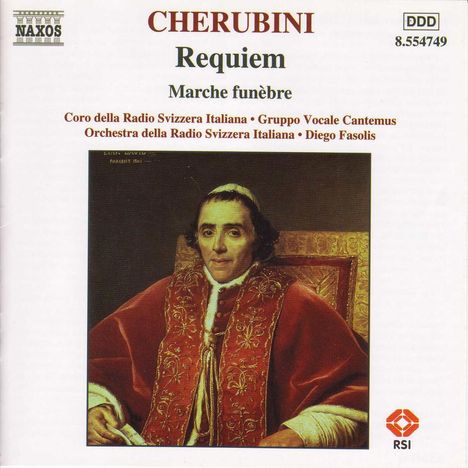Luigi Cherubini: Requiem c-moll auf CD
Requiem c-moll
Herkömmliche CD, die mit allen CD-Playern und Computerlaufwerken, aber auch mit den meisten SACD- oder Multiplayern abspielbar ist.
Voraussichtlich wieder lieferbar Ende Januar 2026
+Marche funebre
- Künstler:
- Gruppo Vocale Cantemus, Orchestra & Coro della Radio Svizzera Italiana, Fasolis
- Label:
- Naxos
- Aufnahmejahr ca.:
- 1996
- Artikelnummer:
- 2956299
- UPC/EAN:
- 0636943474921
- Erscheinungstermin:
- 7.8.2000
Cherubini schrieb sein Requiem in c-Moll in den Jahren 1815 und 1816 zum Gedenken an den Tod Ludwigs XVI., der von den Revolutionären hingerichtet wurde, und es wurde am 21. Januar 1816 in der Krypta von Saint-Denis uraufgeführt. Die geplante Wiederbelebung des Werkes 1834 nach dem Tod von Cherubinis ehemaligem Schüler, dem Komponisten Boieldieu, und der Einspruch des Erzbischofs von Paris gegen die gemeinsame Verwendung von Frauen- und Männerstimmen in einer liturgischen Aufführung veranlasste Cherubini 1836 ein zweites Requiem zu schreiben, das für Männerstimmen komponiert und, wie er es beabsichtigt hatte, bei seinen eigenen Trauerfeierlichkeiten gehört wurde. Das Requiem in c-Moll wurde von Cherubinis Zeitgenossen und Nachfolgern hoch gelobt, von Beethoven und von Berlioz bewundert, von Schumann und von Brahms gefeiert.
Cherubinis Marche funèbre entstand 1820, im Jahr der Ermordung des Duc de Berry, des Sohnes des späteren Karl X. Es gehört zu einer Reihe von Werken, die für die Königskapelle geschrieben wurden, und ist für ein großes Orchester ohne Flöten, die Cherubini ohnehin nicht mochte, aber mit einer Holzbläsergruppe, die ein Kontrafagott und eine Schlagzeuggruppe, die einen Gong verwendet, enthält, komponiert. Letzterer ist zu Beginn zu hören, vor einem Trommelwirbel und dem melancholisch absteigenden Motiv und der aufsteigenden Antwortphrase. Gong und Trommeln werden eingesetzt, um den feierlichen Marsch im weiteren Verlauf zu untermalen.
Product Information
Cherubini wrote his Requiem in C minor in 1815 and 1816 for a commemoration of the death of Louis XVI, executed by the revolutionaries, and it was first performed in the Crypt of Saint-Denis on 21st January 1816. The suggested revival of the work in 1834 at the death of Cherubini's former pupil, the composer Boieldieu, and the objection of the Archbishop of Paris to the use of women's and men's voices together in a liturgical performance led Cherubini to write a second Requiem in 1836, scored for men's voices and heard, as he had intended, at his own obsequies. The Requiem in C minor won high praise from Cherubini's contemporaries and successors, admired by Beethoven and by Berlioz, acclaimed by Schumann and by Brahms.
Cherubini's Marche funèbre was written in 1820, the year of the assassination of the Duc de Berry, son of the future Charles X. It is one of a number of works written for the royal chapel and is scored for a large orchestra, without flutes, which Cherubini, in any case, disliked, but with a woodwind section that includes a double bassoon and a percussion section that makes use of a gong. This last is heard at the outset, before a roll of drums and the melancholy descending motif and ascending answering phrase. Gong and drums are used to punctuate the solemn march, as it proceeds.
Rezensionen
W. Pfister in FonoForum 1/01: "Eine höchst lebendige, im Detail souverän ausformulierte Aufführung - besonders bewundernswert die Intonationssicherheit und schlackelose Reinheit des Chors."Disk 1 von 1 (CD)
-
1 Marche funebre
-
2 Requiem No. 1 in C minor: Introitus et Kyrie: Requiem aeternam
-
3 Requiem No. 1 in C minor: Graduale: Requiem aeternam
-
4 Requiem No. 1 in C minor: Dies irae
-
5 Requiem No. 1 in C minor: Offertorium: Domine Jesu Christe
-
6 Requiem No. 1 in C minor: Sanctus
-
7 Requiem No. 1 in C minor: Pie Jesu
-
8 Requiem No. 1 in C minor: Agnus Dei
Mehr von Luigi Cherubini







